Fluid Bed Coating – Changing Properties of Solids as Desired (German article)
Coating of particles is a critical process step for many manufacturing processes. After all, coating essentially determines the product quality. The appropriate process must be found to determine the properties of as needed for the application. The following article describes, what need to be considered when developing particles.
- Author: Dr. Michael Jacob, Head of Process Technology, and Katja Meyer, Diploma student, both Glatt Ingenieurtechnik GmbH
- originally published in the trade magazine ‘PROCESS’, issue 06/2012, VOGEL Communications Group GmbH & Co. KG
- Fluid Bed Coating – Changing Properties of Solids as Desired (process-worldwide.com)
When developing coating processes the first step for process and product developers is the exact definition of the target parameters, the desired product properties and the determination of the technological and commercial conditions. Based on this a suitable technology for the manufacturing of the desired products must be chosen. The process is normally an incremental one. Originating from a basic concept different production versions are examined and the process is optimized regarding product properties and costs.
Diverse Applications of Fluid Bed Coating
The main application areas for particle coating are quite diverse. They encompass numerous industry segments and include, for example, the following applications:
- rotecting the product and protection against the product
- improving the storage stability of products
- changing or setting release profiles
- reducing the hygroscopicity of solids
- modifying the flowability, surface structure and appearance
- manufacturing composite particles or also
- modifying taste and odour.
Various processing equipment is available to perform coating processes; they differ in their respective basic principles as well as their main application areas. With classical coating (also referred to as encapsulating) dispersed products, e.g. granules, extrudates, crystals or tablets receive an outer layer by spraying a solids-containing liquid on them. A solidification process takes place in the coating equipment which can be impacted in a defined manner through various thermal and flow-related process parameters.
During the process, the coating material is injected as liquid and the normally very dense and homogenous coating film forms immediately on the particle surface through a drying or solidification process. Fluid bed equipment is very frequently used to implement such applications. A fluid bed forms when a gaseous fluidization agent, air or nitrogen, flows through a bulk material so that the particles are fluidized and mixed intensively. The introduction of the liquid into the process chamber of the coating equipment by one or several spray nozzles can take place in different ways (Fig. 1).
Two Scenarios – One Common Goal
In the simplest scenario the liquid is sprayed from the top onto the fluid bed (Top-Spray). By contrast, spraying from the bottom to the top (Bottom Spray) is also possible, especially with viscous spraying media and increased tackiness. Based on the above, an additional process variant has been developed where the particles are moved through the spraying zone in a controlled and uniform manner (Wurster-Bottom-Spray).
This is ensured through the integration of the inner partition around the nozzle as well as the use of specifically designed air distribution plate. This technique allows the application of very uniform coating layers with optimized quality.
The choice of the respective process depends on the product quality to be produced, the properties of the raw materials used as well as the solids to be coated. Important factors are:
- size distribution of the solid to be coated
- viscosity of the spray liquid, the solvent portion (e.g. water) in the spray liquid
- thickness of the coating layer (film thickness) to be applied
- type of spray liquid (solution, suspension, dispersion or melt) or
- requirement regarding uniformity.
In addition to the variables already mentioned, fluidization parameters can also be changed to influence the coating process. For example, products with non-uniform structures, e.g. extrudates, may be coated very effectively in the rotor process.
Coating with Rotor Fluid Beds
In rotor fluid beds – in addition to fluidization by air – mechanical forces are applied to the moving bulk material by using a rotating disk instead of the typical air distribution plate. This rotor disk moves the particles toward the outside where they are moved upwards by an airflow which enters the process chamber through a circular gap. This creates an intensive helical shaped flow of the particles allowing for the very effective tangential spraying (Fig. 1).
Defining Product Properties of Coating Processes
The different coating processes can be applied to achieve different product properties. To demonstrate such effects by way of experiment starter particles (cellets) first received a model active agent layer (NaCl). Using the different coating methods a function layer (Eudragit) was subsequently applied to retard the release of the model active agent (SR: sustained release). The different thermal process conditions were not varied to ensure comparable film formation conditions.
Fig. 2 shows the images of particles from the different process phases. The two coating layers were colored differently for better illustration.
Different Approaches – Different Results
It became apparent that with all process variants optically very uniform and dense coating could be produced. Also the particle size distributions do not vary significantly from each other.
The small differences are certainly caused by the fact that the originating particles (cellets) are relatively coarse (d5O=1250 µm) and the two coating layers with application amounts of seven percent with the model active agent and five percent with the SR Coating are very small.
Examining Methods of Fluid Bed Coating
In contrast to the optical appearance release measurements showed differences between the individual profiles as shown in Fig. 3. Here, the film coating of the rotor apparatus released the active agent the quickest, which can be explained by a comparatively low strength or density of the film coating. The Wurster process, among all variants, provided the most dense coating so that the release took place very slowly. In comparison, a very irregular release was caused by the Top Spray coating. As very broad wall thickness distribution of the SR film applied was suspected to be the reason, caused by the irregular particle movement through the spray zone. The release profile of the Bottom Spray method without inner partition ranges between the Top Spray and Wurster method.
Effective Influence on Solids and Granulates
In summary it can be noted that the application properties of solids can be influenced very effectively and specifically through the coating process. The process variants available – in addition to the substance-related parameters (the recipe parameters) – provide additional options for optimization.
When establishing coating processes in practice, the technology to be used needs to be analyzed systematically during the development phase to be able to achieve optimal product quality. Differences between the process variants can be significant, which, for example, can make the transfer of products between different production systems more difficult.
Another aspect in the process development is the general decision whether the process shall run in batches or continuously. Important decision criteria are, amongst others, the required product volume, the work organization of the company as well as the requirements on the coating quality or uniformity. Rectangular fluid bed units are usually used for continuous coating processes (Fig. 4).
In all practical cases the development phase requires experimental studies, which can be performed at the Technology Center of Glatt Ingenieurtechnik in Weimar on a laboratory and pilot scale. Coating equipment working both in batch mode and continuous can be tested there.
Fluid Bed Coating – Changing Properties of Solids as Desired (process-worldwide.com)
Further information on this topic and related topics can also be found in the following publications:
Published article: ‘How to Tame Recalcitrant Ingredients with Technological Processes’ PDF, English
Published article: ‘Contract manufacturing by fluid bed and spouted bed technology: Which is better, continuous or batch process?’ PDF, English
Published article: ‘Hot-melt applications for the food and beverage industry – How to safely stabilize vitamins and probiotics’ PDF, English
Published article: ‘Customised enzymes for optimal animal feed mixes’ PDF, English
Published article: ‘A matter of gas flow management – Microencapsulation of essential oils by spray granulation unsing spouted bed technology’ PDF, English

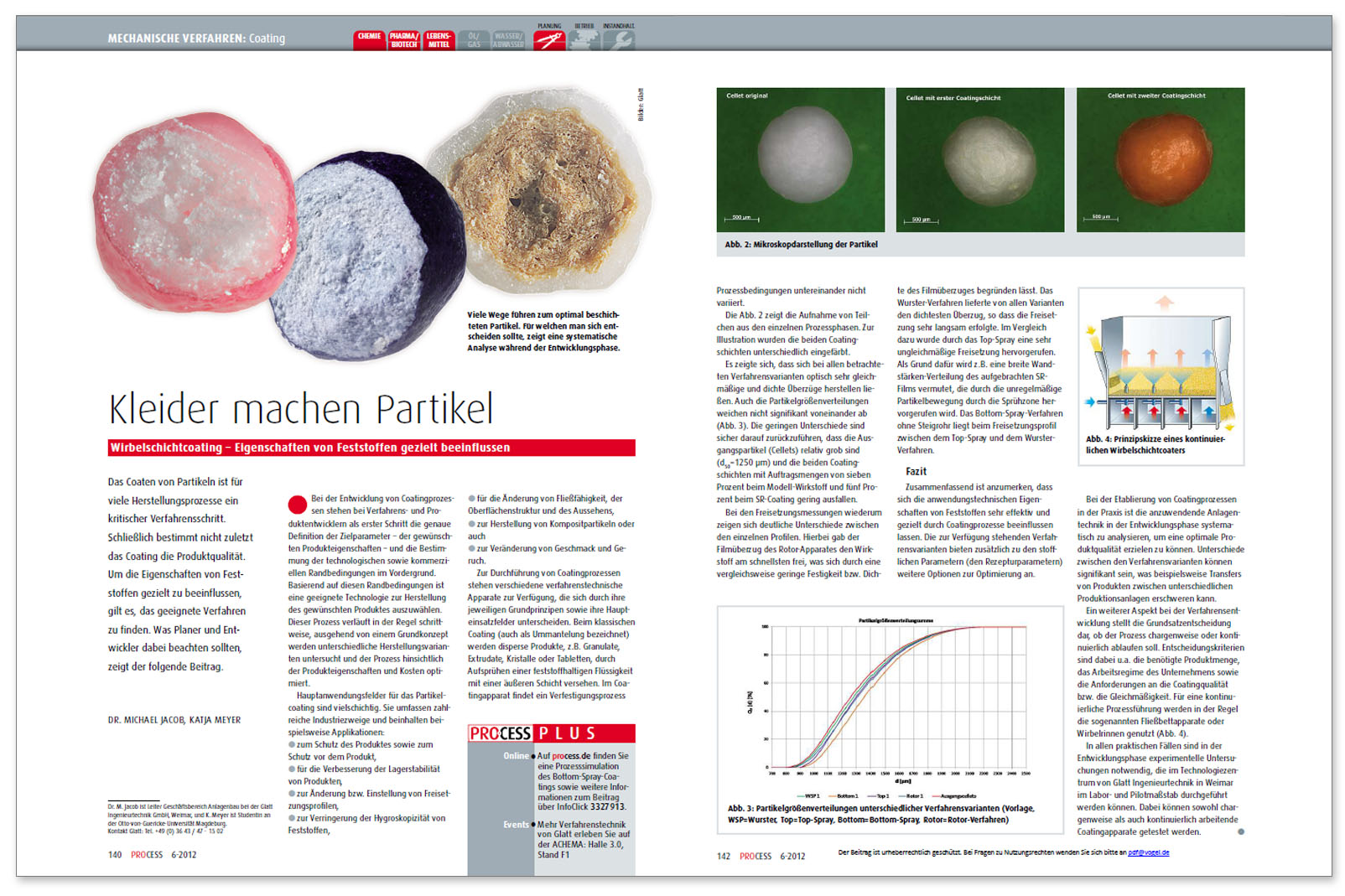
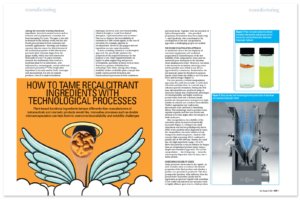
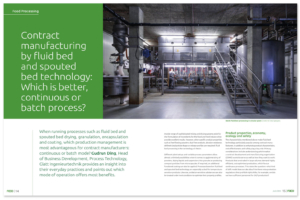
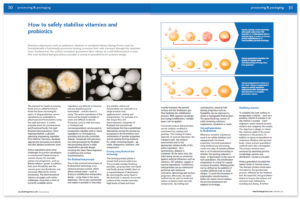

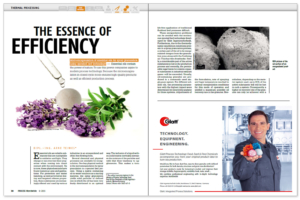
 Copyright: Hüthig GmbH
Copyright: Hüthig GmbH Copyright: Konradin-Verlag Robert Kohlhammer GmbH
Copyright: Konradin-Verlag Robert Kohlhammer GmbH